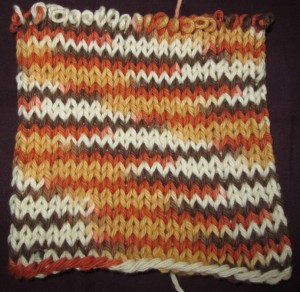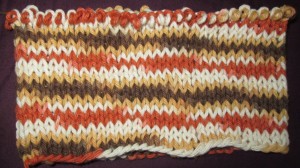Man, I’m a sucker for some variegated yarn.
It can look so nice in the skein.

Rainbow!

Gray scale!

Blues!

Dark Rainbow!
All the colors look fantastic together – and I want all those colors in my project.
The possibilities seem endless. But they’re not. That’s the problem with variegated yarn – what you see on the skein is not what you will see in your knitting and crocheting. Furthermore, you have very little control over how the colors will play out in your work.
I have abandoned many a project with variegated yarn due to being unhappy with how the colors of the yarn work together in that particular pattern. The trick to effectively using variegated yarn is to carefully plan how to use it with your project. This is just like making a swatch – it takes time up front but saves you time in the end.
Unless it’s hand dyed, variegated yarn is made with a repeating pattern. The yarn below has a very simple pattern. If you follow from the bottom up, you can see that there is a longer section of brown, a shorter section of tan, a shorter section of white, a longer section of orange, a shorter section of white, a shorter section of tan, and repeat. Basically, there are two main parts – one long section of brown surrounded by short sections of tan and one long section of orange surrounded by short sections of white. We could abbreviate this as TBBTWOOW.
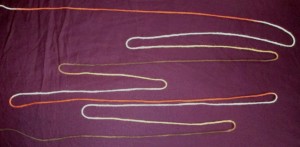
The rigidity and simplicity of this pattern has consequences for how it will work up.
If you knit or crochet back and forth in rows, you will get something like this:
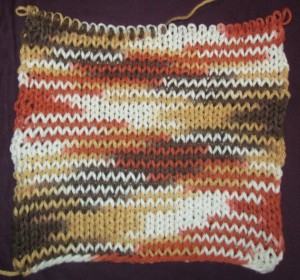
Notice how each color section zigzags back and forth. The orange and brown, which are opposite each other in the TBBTWOOW color scheme, are also opposite each other in the zigzag pattern. the tan and white form a less discernible zigzagging pattern in the background. If you do not do any increases or decreases, this pattern will repeat just like this for the full length of your work.
If you don’t like the way the colors mesh, you can try rows with more or fewer stitches. You will still get the zigzag pattern, but the colors will line up differently:
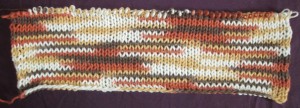
When working in rows with variegated yarn, the edge of the rows looks different from the center. In the detail below, you see that, at the edge, there are two consecutive rows of the same color, but that this ends as you move further into the center.
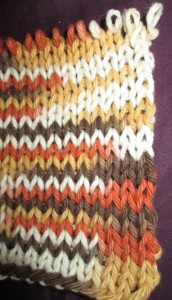
This is due to the fact that when you end one row you are unlikely to end right at the point of a color change, so of course you begin the next row with the same color. It doesn’t matter how many stitches you have in a row or even if you do increases and decreases – you will always get this effect when working in rows with variegated yarn.
You will also see colors start to double up in the middle of the piece when working in rows that are long enough for more than half the color pattern to be used in one row. We can divide the longer piece above into roughly seven sections:
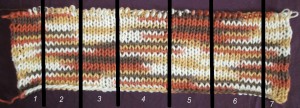
Sections 1, 3, 5, and 7 have this double color effect. You can even see that opposite colors (remember the TBBTWOOW schema) occur in the same row in sections 1 and 5 and in sections 3 and 7. For example, wherever you see brown in section 1, you see orange in the same row in section 5. Wherever you see white in section 3, you see tan in section 7.
As you become more familiar with these patterns, it will be easier to judge from the beginning if you have the right variegated yarn for the project.
Next part: working in the round…









